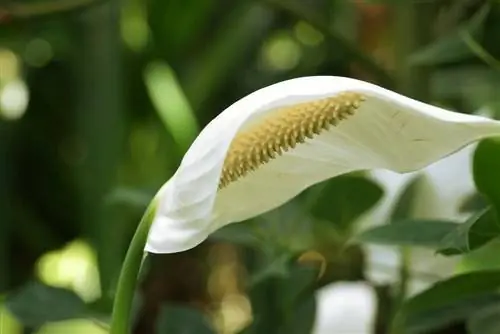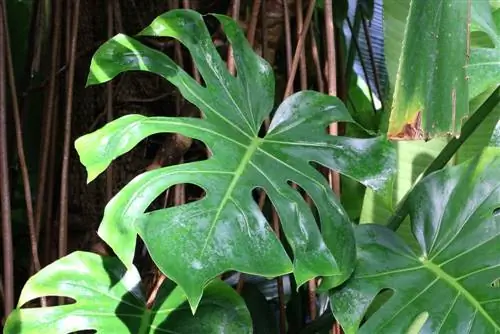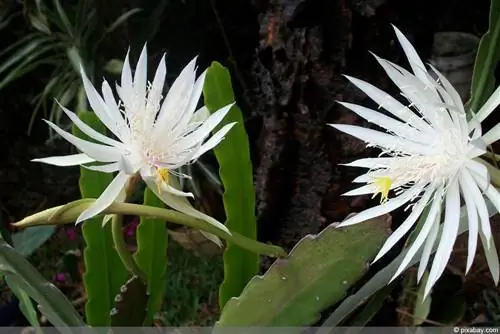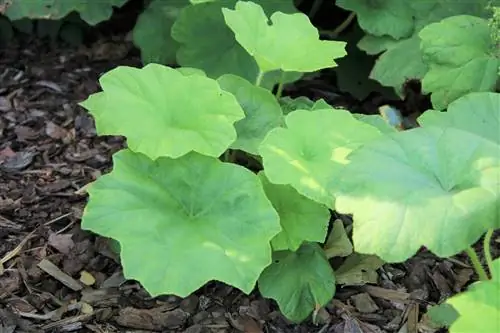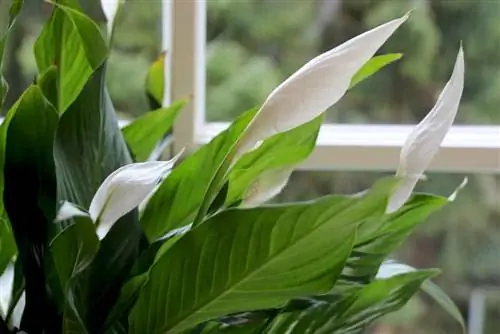- Author admin [email protected].
- Public 2023-12-17 03:39.
- Last modified 2025-01-24 12:45.
Peace lily, scabbard leaf or single leaf, Spathiphyllum has many names. Nevertheless, a single petal is enough for the houseplant to create a cozy and stylish atmosphere. In addition, the popular plant proves to be extremely undemanding. However, the owner still requires an appropriate location and a few care measures. The tips in this guide make cultivation a breeze.
Short profile
- belongs to the arum family (Araceae)
- contains poisonous plant juices
- comes from the tropical areas of America
- now also occurs as a natural wild plant in Europe
- elegant ornamental plant in different varieties
- Growth height varies from variety to variety between 20 and 120 cm
- grows perennial
- blooms white in spring and late summer
- Name is derived from the appearance of the flower
- filters pollutants from the air, ensures a better indoor climate
- but can also cause allergic reactions
Location
The sheath leaf comes from the tropics and therefore only feels comfortable in high humidity. The location should be warm and humid. If temperatures fall below 15°C, the decorative plant loses its charm. The peace lily only accepts temperatures around 12°C at night. At best, the humidity is 60 to 75%. If the chosen location does not meet this requirement, the breeder can help with various measures:
- Spray leaves regularly with low-lime water (especially in winter when the air is warm)
- Place the plant in a saucer filled with water and pebbles (roots must not hang in the water)
- Place a plant next to an indoor fountain
- combine with other aquatic plants if necessary
Air that is too dry is noticeable on brown shoot tips and increases the risk of pest infestation.
Light conditions
It's not just the elegant appearance that makes Spathiphyllum a popular houseplant. A great advantage of the scabbard leaf is its ability to adapt to dark locations. Although the plant grows a little slower in shady corners of the room, it can still be cultivated here without any problems. Of course it is important to note. that every plant needs some light to develop. If necessary, the breeder meets this requirement with artificial lighting. In addition, this measure visually creates a sophisticated atmosphere. Irradiation should not exceed 500 lux.
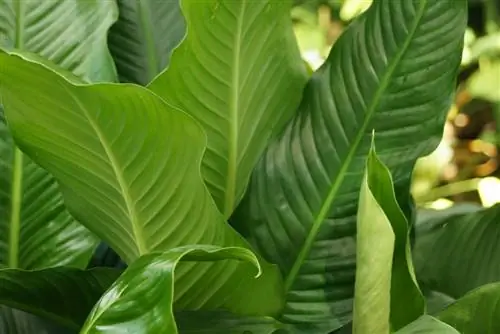
Since Spathiphyllum thrives in the shady ground of the jungle in its tropical homeland, the plant does not tolerate direct sunlight. In general, only three to five hours of sunshine per day are recommended. If you still want to place your plant by the window, you should adhere to the following distance recommendations:
- northern orientation: directly on the windowsill
- west or east orientation: 2 to 3 m distance
- South facing: 3 to 4 m distance
Tip:
The leaf is wonderful in bathrooms. Humidity is usually high here. Darkened bedrooms are also a suitable location. The owner should cultivate the plant out of the reach of children and pets as it contains toxic substances.
Substrate
The scabbard prefers loose, well-drained soil. A pH value of 5 to 6 in the slightly acidic range is considered optimal. Under no circumstances should the substrate contain s alt. The houseplant is even happy with conventional potting soil. In this case, the gardener should definitely set up drainage made of shards, pumice or gravel. Ideally, however, he mixes the substrate himself:
- 5 portions of quality potting soil or compost soil
- 1, 5 to 2 parts of arable soil with clay content
- 1 share of quartz sand
Tip:
To make sure that the substrate you have mixed yourself has the correct pH value, it is best for the gardener to check the acidity using a test strip from a specialist retailer.
Demands on the plant pot
The peace lily hardly takes up any space. A small planter is sufficient. With a diameter of 20 cm, the maximum volume has already been reached. Essentially, the breeder can continue to cultivate the plant as he or she buys it commercially. If it doesn't already exist, you should definitely install drainage. This even makes it possible to keep it hydroponically.
Watering behavior
The scabbard leaf has a comparatively high water consumption. Constant, even watering is therefore recommended. Under no circumstances should the substrate dry out. It is best for the gardener to water the plant as soon as the top layer of soil has dried. Drainage helps against the threat of waterlogging.
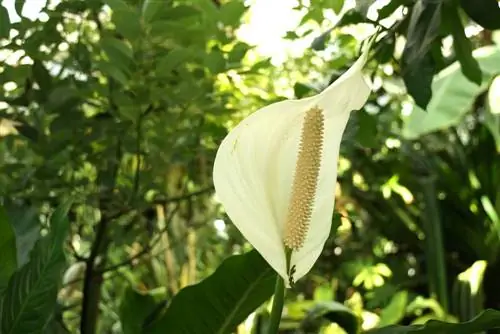
In addition, the amount of watering depends on the location factors. The water requirement increases in bright and warm rooms. Watering is required here about twice a week. The single leaf requires slightly less liquid in the winter months. Then watering every 14 days is sufficient. The gardener should always use low-lime water for this. If you are unsure about the amount and intensity of watering, look at the appearance of the sheath leaf.
Drooping leaves are a clear sign of a lack of water. Interesting to know: Since flooding is not uncommon in the Amazon, the peace lily can even survive completely under the surface of the water for a short time.
Fertilize
After about six to eight weeks, Spathiphyllum has removed almost all of the nutrients from the substrate. During the flowering phase, the grower can therefore help out a little with a liquid complete fertilizer. To promote growth, he administers the nutrients every 14 days. However, fertilizing is not necessary in autumn and winter.
An exception is a warm location. In this case, however, a single dose of nutrients per month is sufficient. The plant warns that the dose is too high with brown speckles on the leaves. It is also advisable to water the substrate first before the grower applies the fertilizer. Since the scabbard leaf is very sensitive to s alt, it is important that the fertilizer is well distributed in the substrate.
Cutting
Pruning is not necessary for the houseplant. Only if the plant grows too bushy should the gardener make a few shaping corrections. However, it is better to divide the plant (see below). If you still prefer to use scissors, proceed as follows:
- remove brown leaf tips
- cut off dried leaves
- removing wilted flowers
- cut off rotting roots
Note:
The gardener cuts off withered flowers as far down the shoot as possible. Restraint is also out of place when it comes to the roots. Here he can safely cut back to the white.
Repotting
How often the grower repots the one-leaf depends on the location factors. Since the plant grows faster in bright places, this care measure should be carried out every year under these conditions. Otherwise, a cycle of three years is usually sufficient, unless the pot becomes visibly too small. The best time to repot spathiphyllum is spring. Since the roots heal best at this time, it is recommended to divide the plant at the same time. Depending on the size of the root ball, far more than ten new plants can be created.
- Dig up a leaf
- Removing soil from root balls
- cut with a sharp knife
- Fill pots with universal or anthurium soil
- Place the pieces again in separate pots
Note:
The peace lily is extremely easy to divide, so no tools are usually required. It is often possible to tear the root ball apart with your bare hands. If fine roots break off, the plant is not damaged.
Methods of propagation & rearing
cutting
If the breeder receives a rootless shoot during division, he simply places it in a container with fresh water. Fine root strands will soon form and he can place the cutting in the ground.
Seeds
Growing from seeds is also possible. The process itself does not require much effort. The gardener needs loose potting soil and must ensure high humidity at around 25°C. Purchasing seeds is much more difficult. Even in well-stocked specialist shops he rarely finds what he is looking for. The chances of success are highest on the Internet. Obtaining seeds from your own plants requires a lot of skill. Several breedings are necessary for this process. It is also necessary to pollinate the plants yourself.
Note: After the gardener has planted a peace lily cutting, he should allow about three months to pass before fertilizing for the first time.
What you need to know about flowers
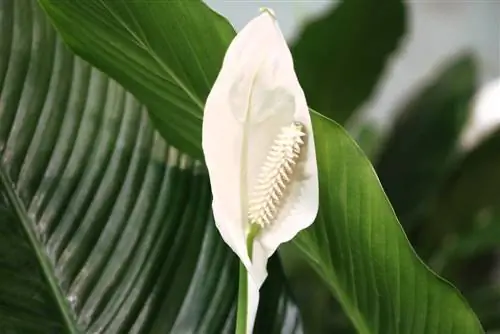
The bright white flower of the single leaf only lasts for around a week. The color then changes to a light green. In this state the scabbard blooms for a full two months. After a three-month break, the buds will appear again. By intentionally causing minor damage to the flower, the gardener stimulates its growth.
Note:
Most sheath leaves on the market bloom continuously, as it is now known how the flowering period can be specifically influenced.
Wintering
Even in winter, the temperature should not fall below 15°C. In a warm environment, the growth of the single leaf remains unchanged. If you want to keep the care effort as low as possible, store the plant at around 16°C. Then it needs less water. The gardener can also reduce the humidity slightly at low temperatures.
Diseases and pests
Unfortunately, mites often visit the houseplant. Above all, the spider mite is considered a typical pest. The parasite can be easily recognized by the spider web-like structures on the shoots. There are hardly any options to actively combat the infestation in closed rooms. Since spider mites usually appear when the air is too dry, it helps to regularly spray the plant with water. If the small animals become visible on the leaves, they can be wiped off with a cloth. Chemical agents are not an alternative as they cause more harm than good to the plant.

